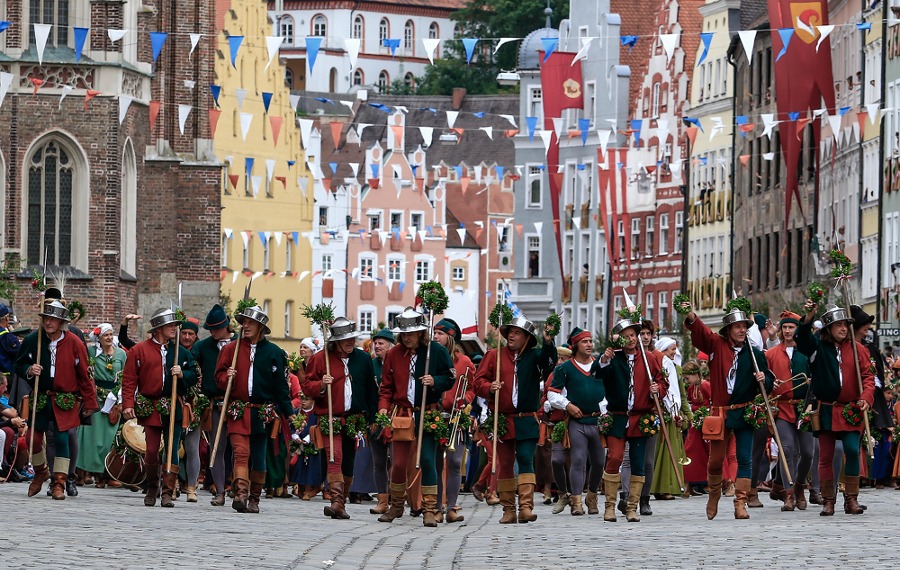Listen to Brenda tell the story
Tourists love Germany’s traditions, even when these “traditions” are sometimes manufactured. All you have to do is go back far enough in time to find an interesting historical event, revive it, and presto! A “tradition” is born, and if you were careful about which one you picked, it can be quite lucrative. Exhibit A: the Landshuter Hochzeit, which is taking place in Landshut from 30 June to 23 July, a reenactment of a wedding from 1475.
It is the brainchild of a couple of enterprising local fellows. Restaurant owner Georg Trippel and factory owner Joseph Linnbrunner founded a society called Die Förderer or sponsors in 1902 for this purpose. The first event took place in 1903 in the form of a play performed by local citizens, eventually growing into the huge spectacle that is now repeated every four years.
Maybe they were inspired by their Bavarian brethren in Oberammergau who were already doing quite nicely with their Passion Play. They probably figured if you can make a business out of a Roman murder mystery, why not a royal wedding? Both Landshut and Oberammergau only allow residents to participate, and all must grow their hair long and wear period costumes.
Personally, I feel Landshut wins hands down in the costume department. Let’s face it. Would you rather dress up in a scratchy burlap sack with string for a belt or a flowing 15th-century taffeta gown with a matching hat?
I thought so.
Today’s open-air medieval celebration began as a strategic political move between a duke nicknamed “George the Rich” – I guess it’s clear what his appeal was – and the Polish princess Hedwig Jagiellon. Conveniently, her brother Vladislav II just happened to be king of neighboring Bohemia – voilà! An instant ally for Bavaria. To get to Landshut, it took the 18-year-old princess and her entourage a whole two months to make the trip from Cracow, a distance of around 800 km (ca. 500 miles). They had to take a detour to avoid not just 15th-century potholes but also areas that were quite literally being plagued.
Regular visitors to the Oktoberfest in nearby Munich will be tempted to don their dirndls and lederhosen, hop on a train, and join in the fun. Many people at the Oktoberfest wear traditional costumes as it’s part of the vibe and outfits are on sale on every Munich street corner. Not only is this not advisable for the Landshut Wedding, it is verboten. You will be turned away at the door as only bona fide participants may come in costume.
Could this be a sartorial rendition of the famous Bavarian Reinheitsgebot, its purity law for beer? An entertaining thought, but in reality it’s to make it as authentic as possible.
The stars of the event are the bridal couple, elected each time in a festive ceremony. A wedding parade features the nuptials in a gilded, horse-drawn carriage, knights on horseback, and cohorts of lance-bearing men representing citizens of the town, knaves, and damsels, all in period costume. The white and black-spotted horses pulling the carriage are brought in especially from Lower Bavaria for this event. Participants come from all across Europe, including Poland, the home country of the bride.
Incidentally, the word “lance” in German is Spieß, giving rise to the derogatory German word Spießer, a person who is square or narrow-minded. Officially recognized citizens of medieval towns, called Bürger, were required to defend the city. Poorer folks could only afford a simple lance as a weapon and were thus looked down upon.
After watching the parade, you can attend a jousting tournament while munching on 15th-century victuals and wash it down with wine made from honey, called mead, or special beer brewed only for this event.
If you want a hassle-free viewing spot, you’ll be happy to hear that enterprising Landshut residents rent out seats at their windows. This gives you a bird’s eye view of the happenings below. They charge hundreds of euros for these seats, but this price graciously includes use of the bathroom. In the year 1475, people would have simply emptied their bedpans out on the street, as sewage systems weren’t introduced until the 19th century.
Finally, not only did they not have toilets, they didn’t have umbrellas or glass bottles, either – so leave those at home, too. You might get wet, but look at it this way: this is the closest to the year 1475 that you’ll ever get.
Brenda Arnold
Title photo copyright Die Förderer
